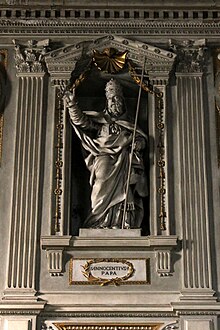Pope Innocent I
Bishop of Rome | |
|---|---|
 Statue in San Martino ai Monti, Rome | |
| Church | Catholic Church |
| Papacy began | 22 December 401[1] |
| Papacy ended | 12 March 417 |
| Predecessor | Anastasius I |
| Successor | Zosimus |
| Personal details | |
| Born | |
| Died | 12 March 417 Rome, Western Roman Empire |
| Sainthood | |
| Feast day |
|
| Venerated in | |
| Other popes named Innocent | |
Pope Innocent I (
The Catholic priest-scholar Johann Peter Kirsch, 1500 years later, described Innocent as a very energetic and highly gifted individual "...who fulfilled admirably the duties of his office".[2]
Family background
According to his biographer in the Liber Pontificalis, Innocent was a native of Albano Laziale and the son of a man called Innocentius.[2] On the other hand, in a letter to Demetriashis contemporary Jerome referred to him as the son of the previous pope, Anastasius I. It has, however, been suggested that Jerome was describing a link merely hierarchical rather than biological.[3] According to Urbano Cerri, Pope Innocent was a native of Albania.[4]
Pontificate
Innocent lost no opportunity to maintain and extend the authority of the
The historian Zosimus, in his Historia Nova, suggests that during the sack of Rome in 410 by Alaric I, Innocent I was willing to permit private pagan practices as a temporary measure. However, Zosimus also suggests that this attempt by pagans to restore public worship failed due to lack of public interest, suggesting that Rome in the previous century had been successfully and permanently won over to Christianity.[5]
Among Innocent I's letters is one to Jerome and another to
He died on 12 March 417. Accordingly, his feast day is now celebrated on 12 March, though from the thirteenth to the twentieth century he was commemorated on 28 July.[7] His successor was Zosimus.
In 405, Pope Innocent sent a list of the sacred books to a Gallic bishop,
Relics
In 846,
See also
References
- ^ "Saint Innocent I | pope".
- ^ a b c
 One or more of the preceding sentences incorporates text from a publication now in the public domain: Kirsch, Johann Peter (1910). "Pope Innocent I". In Herbermann, Charles (ed.). Catholic Encyclopedia. Vol. 8. New York: Robert Appleton Company. Retrieved 15 September 2017.
One or more of the preceding sentences incorporates text from a publication now in the public domain: Kirsch, Johann Peter (1910). "Pope Innocent I". In Herbermann, Charles (ed.). Catholic Encyclopedia. Vol. 8. New York: Robert Appleton Company. Retrieved 15 September 2017.
- ISSN 0042-6032.
- ^ Cerri, Urbano; Steel, Richard (1715). An account of the state of the Roman-Catholick religion throughout the world. Transl. To which is added, A discourse concerning the state of religion in England. Transl. With a large dedication to the present pope, by sir Richard Steele [really B. Hoadly.]. Oxford University. p. 2.
albania.
- ^ a b
 Kirsch, Johann Peter (1910). "Pope Innocent I". In Herbermann, Charles (ed.). Catholic Encyclopedia. Vol. 8. New York: Robert Appleton Company. Retrieved 15 September 2017.
Kirsch, Johann Peter (1910). "Pope Innocent I". In Herbermann, Charles (ed.). Catholic Encyclopedia. Vol. 8. New York: Robert Appleton Company. Retrieved 15 September 2017.
- S2CID 170672101
- ISBN 978-88-209-7210-3)
- ^ a b "Text and translation of the list".
- ISBN 978-0-81322156-4), p. 67
- ISBN 978-1-59856838-7), p. 149
- ISBN 978-0-68481913-6), p. 119
- ^ Birgit Heilmann, Aus Heiltum wird Geschichte. Der Gandersheimer Reliquienschatz in nachreformatorischer Zeit. Thomas Labusiak and Hedwig Röckelein, Regensburg, 2009 (Studien zum Frauenstift Gandersheim und seinen Eigenklöstern, vol. 1).
- ^ "Opening of the present church – Glastonbury Shrine".
External links
- Pope Innocent I at Find a Grave
- Opera Omnia by Migne Patrologia Latina
- Fontes Latinae de papis usque ad annum 530 (Papa Felix IV)
- Liber pontificalis (in Latin)
